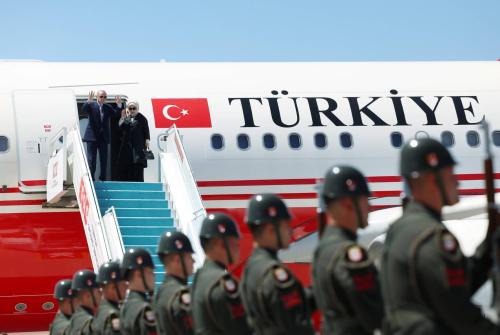In his State of the Union address, President Obama said that his administration will engage Moscow to seek further reductions in U.S. and Russian nuclear arsenals, returning to the nuclear arms-reduction agenda that he first laid out in an April 2009 speech in Prague.
The president in Prague called for reducing the role and number of nuclear weapons in U.S. security policy and embraced the goal of a world free of nuclear arms—though he cautioned that much had to happen in order to get to zero. One year later, in April 2010, he recorded his most important arms-control achievement, signing the New START Treaty.
That treaty began its third year of implementation last week. It requires that the United States and Russia each reduce its nuclear forces to no more than 1,550 deployed strategic warheads on no more than seven hundred deployed strategic missiles and bombers. Those limits kick in fully in 2018.
To be sure, New START represents progress. But its levels hardly make sense twenty years after the end of the Cold War.
The president indicated he is prepared to go further. His administration reportedly is considering seeking to reduce U.S. and Russian nuclear forces to a level of 1,000-1,100 deployed strategic warheads. That would be a welcome step. It would cut the number of Russian warheads capable of striking America by 30 percent.
At the same time, the lower level would mean that the Pentagon could build and operate fewer strategic systems in the future, which would save precious defense dollars. The U.S. military nevertheless would still maintain a robust triad of missiles on submarines, land-based missiles and bombers that would deter any adversary from attacking the United States or its allies.
The White House reportedly also would like to expand reductions to include all U.S. and Russian nuclear weapons—reserve strategic warheads and tactical (or non-strategic) weapons as well as deployed strategic warheads. That makes sense as the distinction between strategic and non-strategic becomes increasingly blurry.
At present, New START covers only one-third of the Russian and American arsenals. By constraining all nuclear weapons, a new approach would address the large number of Russian tactical nuclear arms that concern U.S. allies in Europe and Asia. They worry the Senate as well; ratification opponents criticized New START for failing to include tactical weapons.
Limiting all U.S. and Russian nuclear weapons would put Washington and Moscow in a stronger position to insist that any subsequent reductions involve the other nuclear weapons states, most of whose weapons are not strategic.
The Obama administration will face two big challenges in reinvigorating the nuclear agenda. First, how will Moscow respond? The Russians have shown little enthusiasm for further cuts and bear much responsibility for the fact that arms control languished in 2011-2012.
The Russians, however, may have incentives to engage. The U.S. military can with its current force structure easily stay at the New START limits, while the Russian military must build new missiles to do so. Lowering the limits would offer Moscow a chance to save money. Also of interest to the Russians: putting all weapons on the table would mean constraining reserve strategic warheads, where the U.S. military has a significant numerical advantage.
If the Russians engage—admittedly, still an open question—Republicans in the Senate will pose the second big challenge. They are skeptical of arms control in general. The White House and others were surprised by how tough it was to secure ratification of New START. Would Senate Republicans consent to ratification of a new treaty with lower limits? Or would the administration adopt a less formal approach that would obviate the need for Senate approval?
It is not clear whether President Obama’s new arms-reduction push will be able to overcome these challenges. In any case, he should test the proposition with the Russians and put this issue at the top of the agenda when national-security advisor Tom Donilon visits Moscow later this month.
If the Russians show interest, long months of hard bargaining will lie ahead. The sides will have to deal with questions—such as verifying limits on nuclear weapons at storage sites—that they have not faced before. Then there might (or might not) be a debate in the Senate. But success would mean that the president could leave a transformational nuclear legacy when he departs office in 2017. More importantly, Americans would be safer and more secure.
The Brookings Institution is committed to quality, independence, and impact.
We are supported by a diverse array of funders. In line with our values and policies, each Brookings publication represents the sole views of its author(s).



Commentary
Op-edObama Renews Arms-Control Push
February 20, 2013